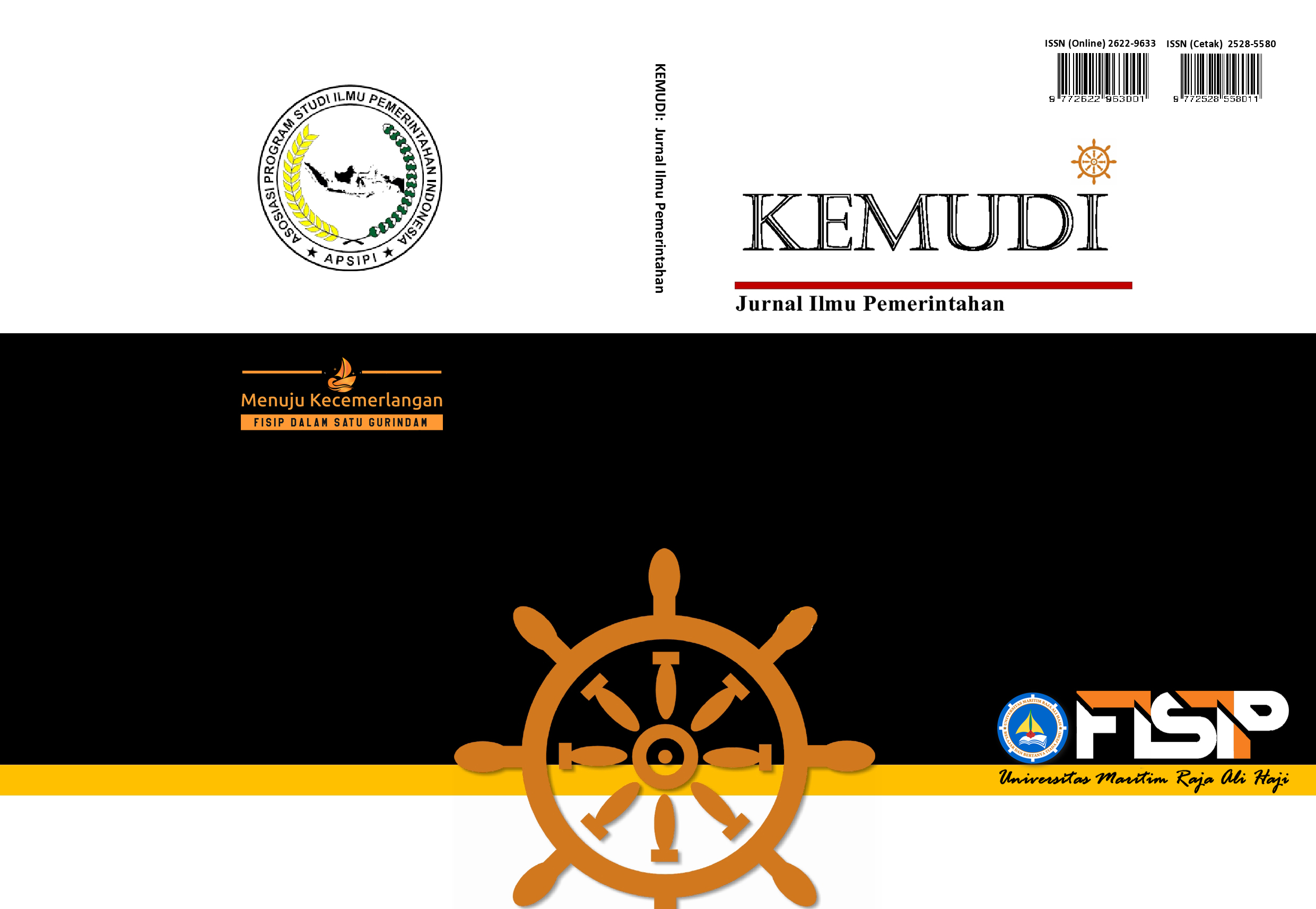Jokowi's Agrarian Politics in the Agrarian Reform Program
DOI:
https://doi.org/10.31629/kemudi.v10i1.7405Keywords:
Agrarian , Jokowi, PoliticsAbstract
This research is intended to see how Jokowi's agrarian politics is in the agrarian reform program. Indonesia is a country with a very high level of inequality in land tenure. By using a qualitative descriptive research approach, this research takes data from online media, the Institute's website, stakeholder statements, and government documents. The results of this study indicate that the majority of land ownership in Indonesia, which is less than 2 hectares, is 50,508,676 parcels with a total land area of 9,921,994.28 hectares. Meanwhile, land ownership is more than 20 hectares, which is only 4,878 parcels with a land area of 4,508,366.46. If using the world bank criteria, the inequality value in the 6 main islands in Indonesia is at a high inequality value because it is at < 12% of the value of the inequality. Meanwhile, with the implementation of the agrarian reform program from 2015-to 2020, the Jokowi government is only able to distribute 1.46 million hectares of land. This study concludes that the Jokowi government's agrarian politics is the same as the feudalism-style land tenure pattern which relies on land monopoly control.
Downloads
References
Buku-buku
DD Siregar, Asset Management Strategy for Structuring the Concept of National Sustainable Development in the Context of Regional Heads as CEO in the Era of Globalization. Jakarta: PT. Gramedia Main Library, 2004.
A. Rahman, Agrarian Politics. 2019. [Online]. Available: https://ilmupolitik.unja.ac.id/wp-content/uploads/2019/12/Buku-ajar-polAG_bab-11.pdf
Jurnal
Abdul, Kadir Jaelani dan Udiyo Basuki. "Illegal Unreported And Unregulated (IUU) Fishing: Upaya Mencegah Dan Memberantas Illegal Fishing Dalam Membangun Poros Maritim Indonesia." Supremasi Hukum, Juni 2014: Volume 3, Nomor 1.
M. F. Sitorus, “Kerangka Dan Metode Kajian Agraria,” J. Anal. Sos., vol. 9, no. 1, pp. 111–124, 2004.
N. F. Rachman, “Memahami Reorganisasi Ruang Melalui Perspektif Politik Agraria,” BHUMI J. Agrar. dan Pertanah., vol. 1, no. 1, pp. 33–44, 2018, [Online]. Available: https://jurnalbhumi.stpn.ac.id/index.php/JB/article/view/39/51
D. D. Siregar, Management Aset Strategi Penataan Konsep Pembangunan Berkelanjutan Secara Nasional dalam Konteks Kepala Daerah Sebagai CEO’s pada Era Globalisasi. Jakarta: PT. Gramedia Pustaka Utama, 2004.
A. Rahman, Politik Agraria. 2019. [Online]. Available: https://ilmupolitik.unja.ac.id/wp-content/uploads/2019/12/Buku-ajar-polAG_bab-11.pdf
M. F. Sitorus, “Kerangka Dan Metode Kajian Agraria,” J. Anal. Sos., vol. 9, no. 1, pp. 111–124, 2004.
N. F. Rachman, “Memahami Reorganisasi Ruang Melalui Perspektif Politik Agraria,” BHUMI J. Agrar. dan Pertanah., vol. 1, no. 1, pp. 33–44, 2018, [Online]. Available: https://jurnalbhumi.stpn.ac.id/index.php/JB/article/view/39/51
Sediono MP. Tjondronegoro and Gunawan Wiradi, “Menelusuri Pengertian Istilah ‘Agraria,’” J. Anal. Sos., vol. 9, no. 1, pp. 1–8, 2004.
Ramadhani, “Peran Poltik Terhadap Pembangunan Hukum Agraria Nasional,” SosekJurnal Sos. dan Ekon., vol. 1, no. 1, pp. 1–6, 2020.
A. T. Hidayat, “Berasal Dari Tanah Cabutan Asing ( Studi Kasus Kabupaten Bangli Provinsi Bali ) Implementation of Agrarian Reform Comes From Confiscated Foreign Land ( Case Study of Bangli Regency in Bali Province ),” no. 86, pp. 2020–2024, 2020.
I. Nurdin, “Mewujudkan Desa Maju Reforma Agraria,” BHUMI J. Agrar. dan Pertanah., vol. 3, no. 1, p. 82, 2017, doi: 10.31292/jb.v3i1.92.
M. I. Arisaputra, “Reforma Agraria Untuk Mewujudkan Kedaulatan Pangan,” Rechtidee., vol 10,no 1 pp. 39–59, 2015, https://doi.org/10.21107/ri.v10i1.1138 .
N. Syahyuti, “Pengaruh Politik Agraria Terhadap Perubahan Pola Penguasaan Tanah dan Struktur Pedesaan di Indonesia,” Forum Penelit. Agro Ekon., vol. 19, no. 1, p. 21, 2016, doi: 10.21082/fae.v19n1.2001.21-32.
N. Syahyuti, “Kendala Pelaksanaan Landreform di Indonesia: Analisa terhadap Kondisi dan Perkembangan Berbagai Faktor Prasyarat Pelaksanaan Reforma Agraria,” Forum Penelit. Agro Ekon., vol. 22, no. 2, p. 89, 2016, doi: 10.21082/fae.v22n2.2004.89-101.
P. P. dan P. K. A. dan T. R. P. Nasiona, Laporan Akhir Penelitian Internal, no. 8. 2018. [Online]. Available: https://digilib.esaunggul.ac.id/public/UEU-Research-11986-16_0243.pdf
M. Mizero, A. Karangwa, P. Burny, B. Michel, and P. Lebailly, “Agrarian and land reforms in Rwanda: Situation and perspectives,” Agris On-line Pap. Econ. Informatics, vol. 10, no. 3, pp. 79–92, 2018, doi: 10.7160/aol.2018.100307
R. Pereira, C. S. Simmons, and R. Walker, “Smallholders, agrarian reform, and globalization in the Brazilian amazon: Cattle versus the environment,” Land, vol. 5, no. 3, pp. 1–15, 2016, doi: 10.3390/land5030024.
Data Internet
Dianto Bachriadi, “REFORMA AGRARIA UNTUK INDONESIA” https://arc.or.id/wp-content/uploads/2018/08/WP-07-KAPPOB-I-2017-RA-SBY-D-Bachriadi.pdf
P. S. M. ('Jun’) B. Jr., “Land politics, agrarian movements and sholar-actvism,” https://www.tni.org/files/publication-downloads/borras_inaugural_lecture_14_april_2016_final_formatted_pdf_for_printing.pdf
Peraturan Perundang-undangan
Directions from the Presidential Staff Office, “National Strategy for the Implementation of Agrarian Reform 2016-2019,” no. April 2016, pp. 1–64, 2016, [Online]. Available: https://hanibalhamidi.files.wordpress.com/2016/09/naskah-stranas-pelaksanaan-reforma-agraria-ksp.pdf
Downloads
Published
Issue
Section
License
Copyright (c) 2025 KEMUDI : Jurnal Ilmu Pemerintahan

This work is licensed under a Creative Commons Attribution-NonCommercial-ShareAlike 4.0 International License.




